engine overheat YAMAHA SUPERJET 2022 Owners Manual
[x] Cancel search | Manufacturer: YAMAHA, Model Year: 2022, Model line: SUPERJET, Model: YAMAHA SUPERJET 2022Pages: 84, PDF Size: 3.76 MB
Page 27 of 84

Control function operation
20
EJU31027
Watercraft control functionsEJU45552Engine stop/“L-MODE” switch “ ”
The engine stop/“L-MODE” switch (red but-
ton) stops the engine when the switch is
pushed. You can also activate L-MODE.
EJU31164Engine shut-off switch “ ”
The engine shut-off switch automatically
stops the engine when the clip, on the end of
the engine shut-off cord (lanyard), is removed
from the switch, such as if the operator falls
off the watercraft.
Insert the clip under the engine shut-off
switch before starting the engine.
When the engine is not running, remove the
clip from the engine shut-off switch to pre-vent accidental starting or unauthorized op-
eration by children or others.
EJU45561Start switch “ ”ECJ01361
Do not run the engine for more than 15
seconds on land without supplying water,
otherwise the engine could overheat.
The start switch (green button) starts the en-
gine when the switch is pushed.
Release the start switch as soon as the en-
gine starts to run. If the engine does not start
in 5 seconds, release the start switch, wait 15
seconds, and then try again.
NOTICE: Never
push the start switch while the engine is
running. Do not operate the start switch
for more than 5 seconds, otherwise the
battery will be discharged and the engine
1 Engine stop/“L-MODE” switch
1 Clip
2 Engine shut-off switch
3 Engine shut-off cord (lanyard)
1
1
2
3
UF4R71E0.book Page 20 Monday, May 10, 2021 1:14 PM
Page 32 of 84

Instrument operation
25
same time, the maximum engine speed is
limited.
If the oil pressure warning is activated, imme-
diately reduce the engine speed, return to
shore, and then check the engine oil level.
(See page 33 for information on checking the
engine oil level.) If the oil level is sufficient,
have a Yamaha dealer check the watercraft.
EJU45660Engine overheat warning
If the engine temperature rises significantly,
the “WARNING” indicator light comes on.
While the engine overheat warning is activat-
ed, the maximum engine speed is limited.
If the engine overheat warning is activated,
immediately reduce the engine speed, return
to shore, and then make sure that water is
being discharged from the cooling water pilot
outlet while the engine is running. If there is
no discharge of water, stop the engine, and
then check the jet intake for clogging. (See
page 72 for information on the jet intake.)NOTICE:
If you cannot locate and correct
the cause of the overheating, consult a
Yamaha dealer. Continuing to operate at higher speeds could result in severe en-
gine damage.
[ECJ00042]
EJU45681
Check engine warning
If a sensor malfunction or a short circuit is de-
tected, the “WARNING” indicator light blinks
once for several seconds.
If the check engine warning is activated, im-
mediately reduce the engine speed, return to
shore, and have a Yamaha dealer check the
engine.
EJU45690Communication disconnecting warning
If communication disconnecting is detected,
the “WARNING” indicator light and “L-
MODE” indicator light blink.
If the communication disconnecting warning
is activated, have the watercraft serviced by
a Yamaha dealer as soon as possible.
UF4R71E0.book Page 25 Monday, May 10, 2021 1:14 PM
Page 51 of 84
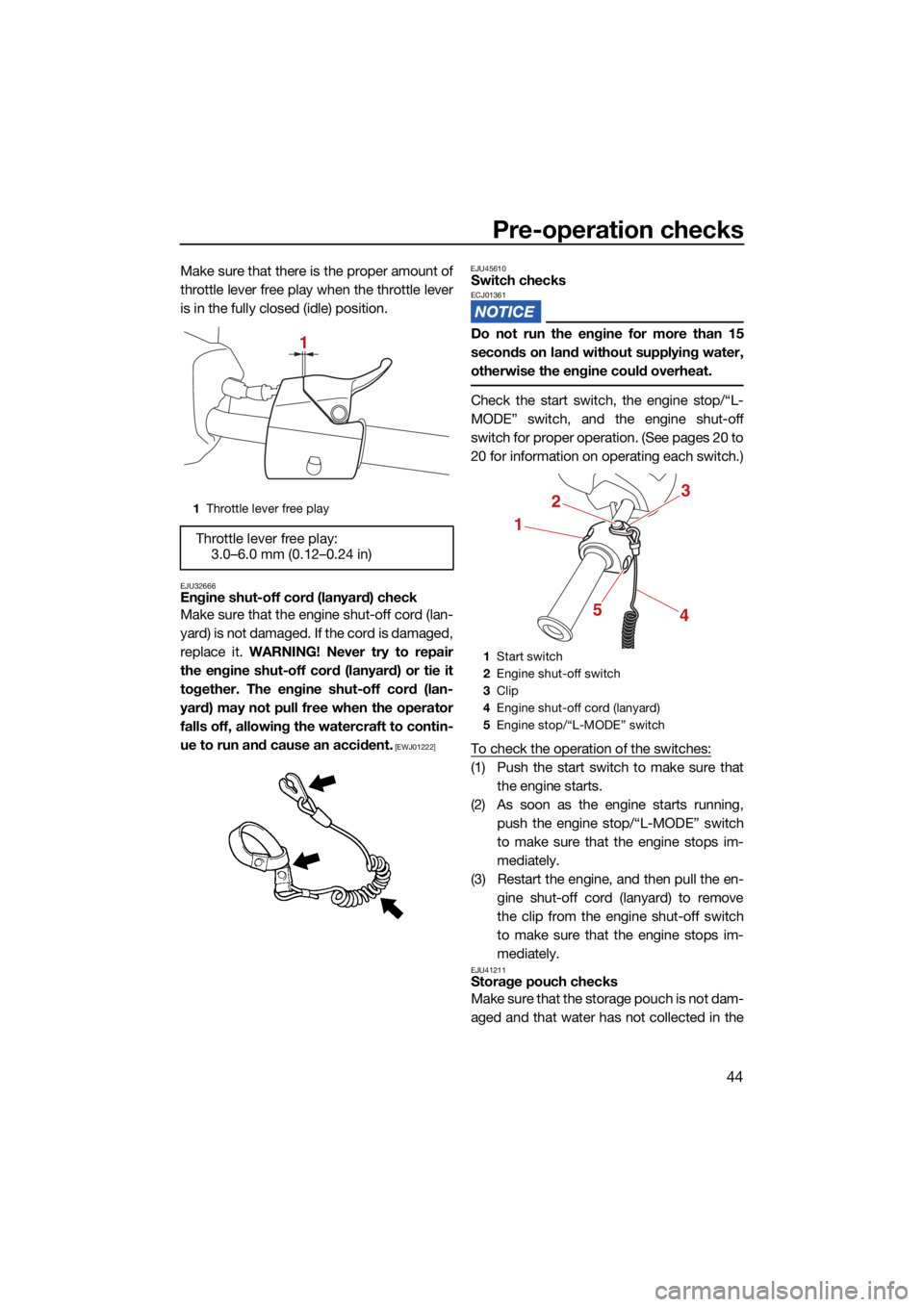
Pre-operation checks
44
Make sure that there is the proper amount of
throttle lever free play when the throttle lever
is in the fully closed (idle) position.
EJU32666Engine shut-off cord (lanyard) check
Make sure that the engine shut-off cord (lan-
yard) is not damaged. If the cord is damaged,
replace it. WARNING! Never try to repair
the engine shut-off cord (lanyard) or tie it
together. The engine shut-off cord (lan-
yard) may not pull free when the operator
falls off, allowing the watercraft to contin-
ue to run and cause an accident.
[EWJ01222] EJU45610
Switch checksECJ01361
Do not run the engine for more than 15
seconds on land without supplying water,
otherwise the engine could overheat.
Check the start switch, the engine stop/“L-
MODE” switch, and the engine shut-off
switch for proper operation. (See pages 20 to
20 for information on operating each switch.)
To check the operation of the switches:
(1) Push the start switch to make sure that
the engine starts.
(2) As soon as the engine starts running, push the engine stop/“L-MODE” switch
to make sure that the engine stops im-
mediately.
(3) Restart the engine, and then pull the en- gine shut-off cord (lanyard) to remove
the clip from the engine shut-off switch
to make sure that the engine stops im-
mediately.
EJU41211Storage pouch checks
Make sure that the storage pouch is not dam-
aged and that water has not collected in the
1Throttle lever free play
Throttle lever free play:
3.0–6.0 mm (0.12–0.24 in)
1
1Start switch
2 Engine shut-off switch
3 Clip
4 Engine shut-off cord (lanyard)
5 Engine stop/“L-MODE” switch
3
1
5 4
2
UF4R71E0.book Page 44 Monday, May 10, 2021 1:14 PM
Page 55 of 84
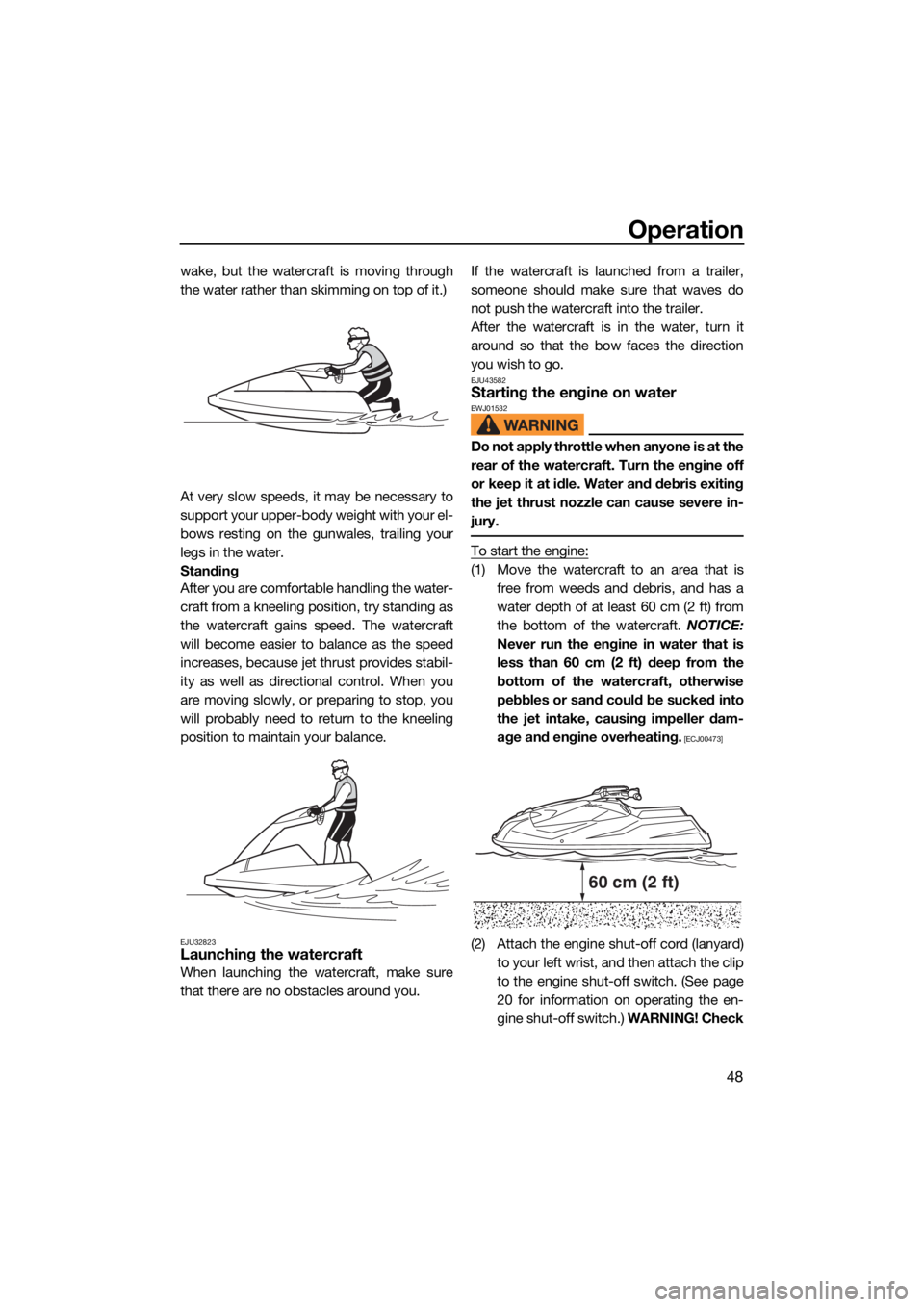
Operation
48
wake, but the watercraft is moving through
the water rather than skimming on top of it.)
At very slow speeds, it may be necessary to
support your upper-body weight with your el-
bows resting on the gunwales, trailing your
legs in the water.
Standing
After you are comfortable handling the water-
craft from a kneeling position, try standing as
the watercraft gains speed. The watercraft
will become easier to balance as the speed
increases, because jet thrust provides stabil-
ity as well as directional control. When you
are moving slowly, or preparing to stop, you
will probably need to return to the kneeling
position to maintain your balance.
EJU32823Launching the watercraft
When launching the watercraft, make sure
that there are no obstacles around you.If the watercraft is launched from a trailer,
someone should make sure that waves do
not push the watercraft into the trailer.
After the watercraft is in the water, turn it
around so that the bow faces the direction
you wish to go.
EJU43582Starting the engine on waterEWJ01532
Do not apply throttle when anyone is at the
rear of the watercraft. Turn the engine off
or keep it at idle. Water and debris exiting
the jet thrust nozzle can cause severe in-
jury.
To start the engine:
(1) Move the watercraft to an area that is
free from weeds and debris, and has a
water depth of at least 60 cm (2 ft) from
the bottom of the watercraft. NOTICE:
Never run the engine in water that is
less than 60 cm (2 ft) deep from the
bottom of the watercraft, otherwise
pebbles or sand could be sucked into
the jet intake, causing impeller dam-
age and engine overheating.
[ECJ00473]
(2) Attach the engine shut-off cord (lanyard) to your left wrist, and then attach the clip
to the engine shut-off switch. (See page
20 for information on operating the en-
gine shut-off switch.) WARNING! Check
60 cm (2 ft)
UF4R71E0.book Page 48 Monday, May 10, 2021 1:14 PM
Page 59 of 84
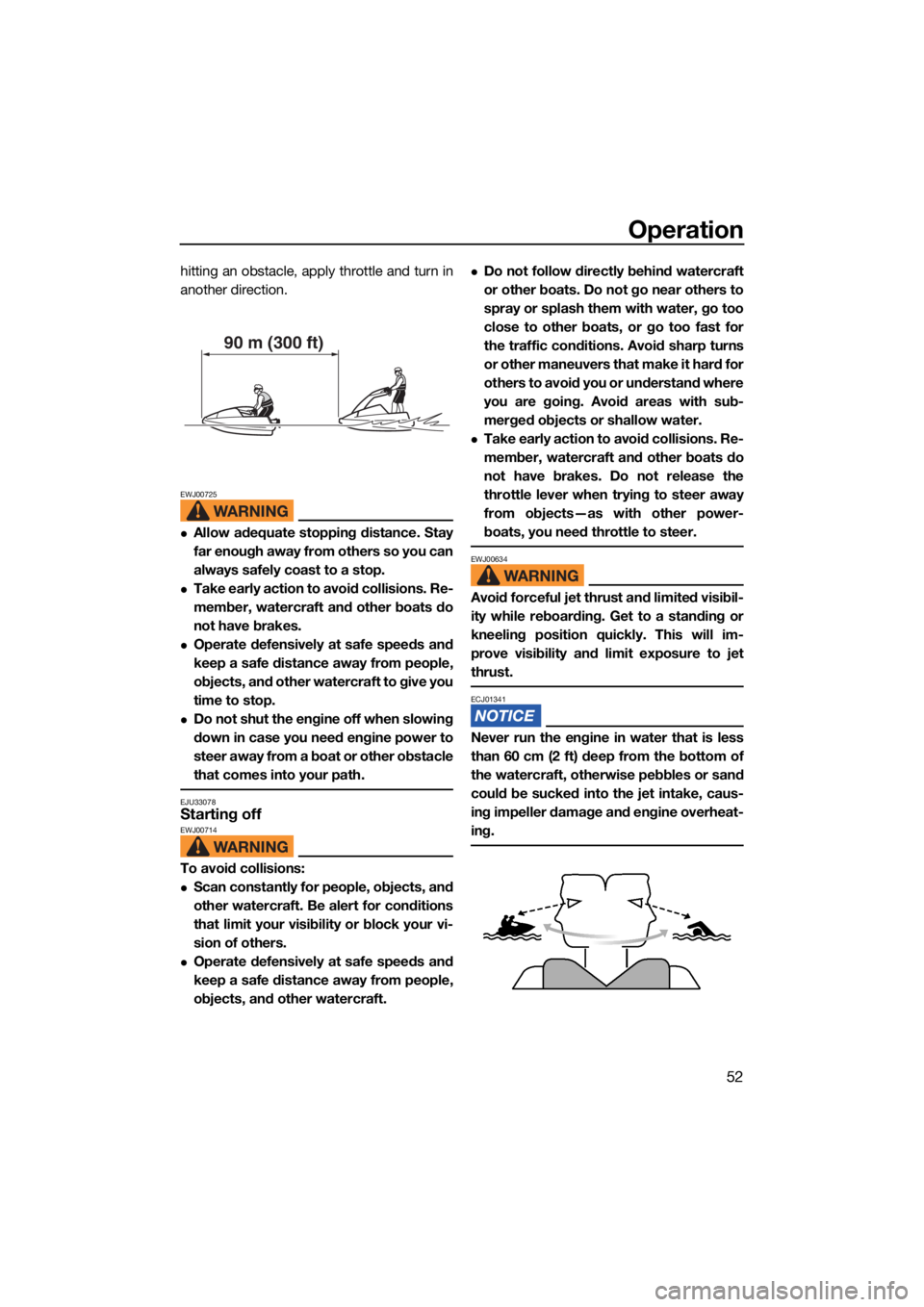
Operation
52
hitting an obstacle, apply throttle and turn in
another direction.
EWJ00725
Allow adequate stopping distance. Stay
far enough away from others so you can
always safely coast to a stop.
Take early action to avoid collisions. Re-
member, watercraft and other boats do
not have brakes.
Operate defensively at safe speeds and
keep a safe distance away from people,
objects, and other watercraft to give you
time to stop.
Do not shut the engine off when slowing
down in case you need engine power to
steer away from a boat or other obstacle
that comes into your path.
EJU33078Starting offEWJ00714
To avoid collisions:
Scan constantly for people, objects, and
other watercraft. Be alert for conditions
that limit your visibility or block your vi-
sion of others.
Operate defensively at safe speeds and
keep a safe distance away from people,
objects, and other watercraft.
Do not follow directly behind watercraft
or other boats. Do not go near others to
spray or splash them with water, go too
close to other boats, or go too fast for
the traffic conditions. Avoid sharp turns
or other maneuvers that make it hard for
others to avoid you or understand where
you are going. Avoid areas with sub-
merged objects or shallow water.
Take early action to avoid collisions. Re-
member, watercraft and other boats do
not have brakes. Do not release the
throttle lever when trying to steer away
from objects—as with other power-
boats, you need throttle to steer.
EWJ00634
Avoid forceful jet thrust and limited visibil-
ity while reboarding. Get to a standing or
kneeling position quickly. This will im-
prove visibility and limit exposure to jet
thrust.
ECJ01341
Never run the engine in water that is less
than 60 cm (2 ft) deep from the bottom of
the watercraft, otherwise pebbles or sand
could be sucked into the jet intake, caus-
ing impeller damage and engine overheat-
ing.
90 m (300 ft)
UF4R71E0.book Page 52 Monday, May 10, 2021 1:14 PM
Page 62 of 84
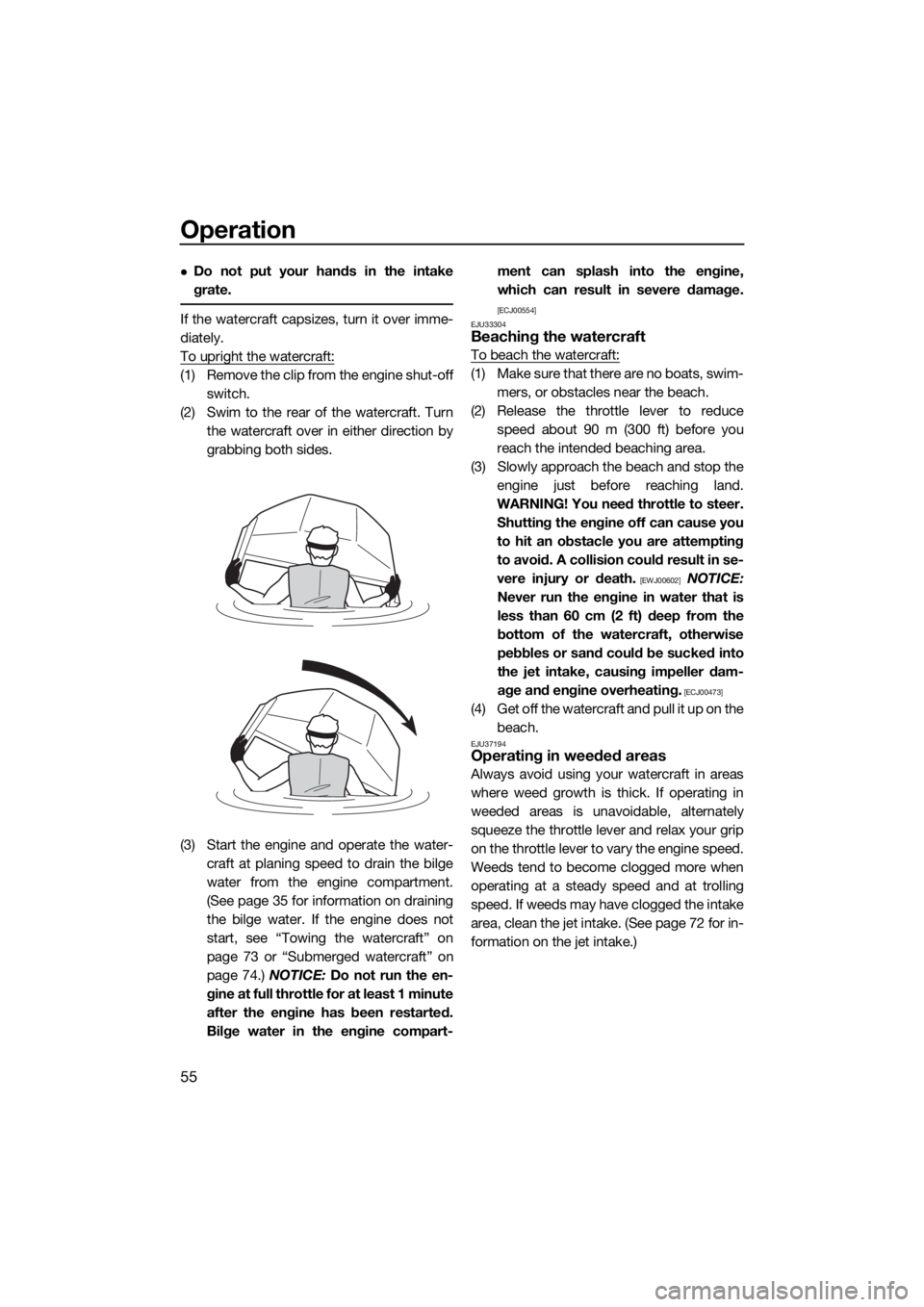
Operation
55
Do not put your hands in the intake
grate.
If the watercraft capsizes, turn it over imme-
diately.
To upright the watercraft:
(1) Remove the clip from the engine shut-offswitch.
(2) Swim to the rear of the watercraft. Turn the watercraft over in either direction by
grabbing both sides.
(3) Start the engine and operate the water- craft at planing speed to drain the bilge
water from the engine compartment.
(See page 35 for information on draining
the bilge water. If the engine does not
start, see “Towing the watercraft” on
page 73 or “Submerged watercraft” on
page 74.) NOTICE: Do not run the en-
gine at full throttle for at least 1 minute
after the engine has been restarted.
Bilge water in the engine compart- ment can splash into the engine,
which can result in severe damage.
[ECJ00554]
EJU33304
Beaching the watercraft
To beach the watercraft:
(1) Make sure that there are no boats, swim- mers, or obstacles near the beach.
(2) Release the throttle lever to reduce speed about 90 m (300 ft) before you
reach the intended beaching area.
(3) Slowly approach the beach and stop the engine just before reaching land.
WARNING! You need throttle to steer. Shutting the engine off can cause you
to hit an obstacle you are attempting
to avoid. A collision could result in se-
vere injury or death.
[EWJ00602] NOTICE:
Never run the engine in water that is
less than 60 cm (2 ft) deep from the
bottom of the watercraft, otherwise
pebbles or sand could be sucked into
the jet intake, causing impeller dam-
age and engine overheating.
[ECJ00473]
( 4 ) G e t o f f t h e w a t e r c r a f t a n d p u l l i t u p o n t h e beach.
EJU37194Operating in weeded areas
Always avoid using your watercraft in areas
where weed growth is thick. If operating in
weeded areas is unavoidable, alternately
squeeze the throttle lever and relax your grip
on the throttle lever to vary the engine speed.
Weeds tend to become clogged more when
operating at a steady speed and at trolling
speed. If weeds may have clogged the intake
area, clean the jet intake. (See page 72 for in-
formation on the jet intake.)
UF4R71E0.book Page 55 Monday, May 10, 2021 1:14 PM
Page 63 of 84

Operation
56
EJU41062After removing the watercraft from
the water
ECJ01361
Do not run the engine for more than 15
seconds on land without supplying water,
otherwise the engine could overheat.
After operating and removing the watercraft
from the water, promptly discharge the re-
maining water from the cooling water pas-
sages.
To discharge water from the cooling water
passages:
(1) Make sure that the area around the wa- tercraft is clear, and then start the en-
gine.
(2) Discharge the remaining water out of the cooling water passages by alternately
squeezing and releasing the throttle lever
quickly for 10 to 15 seconds.
(3) Stop the engine.
UF4R71E0.book Page 56 Monday, May 10, 2021 1:14 PM
Page 64 of 84
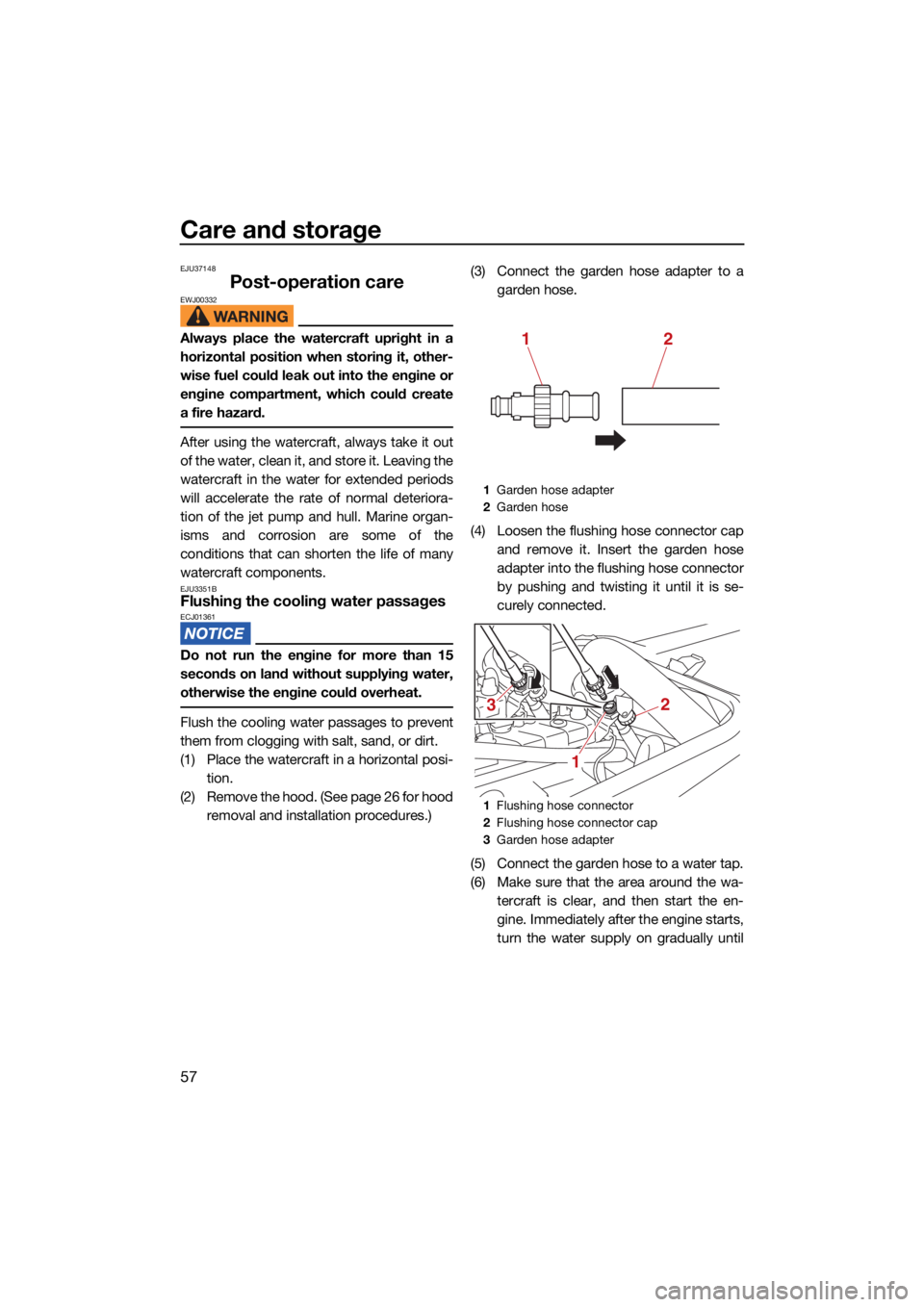
Care and storage
57
EJU37148
Post-operation careEWJ00332
Always place the watercraft upright in a
horizontal position when storing it, other-
wise fuel could leak out into the engine or
engine compartment, which could create
a fire hazard.
After using the watercraft, always take it out
of the water, clean it, and store it. Leaving the
watercraft in the water for extended periods
will accelerate the rate of normal deteriora-
tion of the jet pump and hull. Marine organ-
isms and corrosion are some of the
conditions that can shorten the life of many
watercraft components.
EJU3351BFlushing the cooling water passagesECJ01361
Do not run the engine for more than 15
seconds on land without supplying water,
otherwise the engine could overheat.
Flush the cooling water passages to prevent
them from clogging with salt, sand, or dirt.
(1) Place the watercraft in a horizontal posi-tion.
(2) Remove the hood. (See page 26 for hood removal and installation procedures.) (3) Connect the garden hose adapter to a
garden hose.
(4) Loosen the flushing hose connector cap and remove it. Insert the garden hose
adapter into the flushing hose connector
by pushing and twisting it until it is se-
curely connected.
(5) Connect the garden hose to a water tap.
(6) Make sure that the area around the wa- tercraft is clear, and then start the en-
gine. Immediately after the engine starts,
turn the water supply on gradually until
1Garden hose adapter
2 Garden hose
1 Flushing hose connector
2 Flushing hose connector cap
3 Garden hose adapter
12
2
1
3
UF4R71E0.book Page 57 Monday, May 10, 2021 1:14 PM
Page 68 of 84
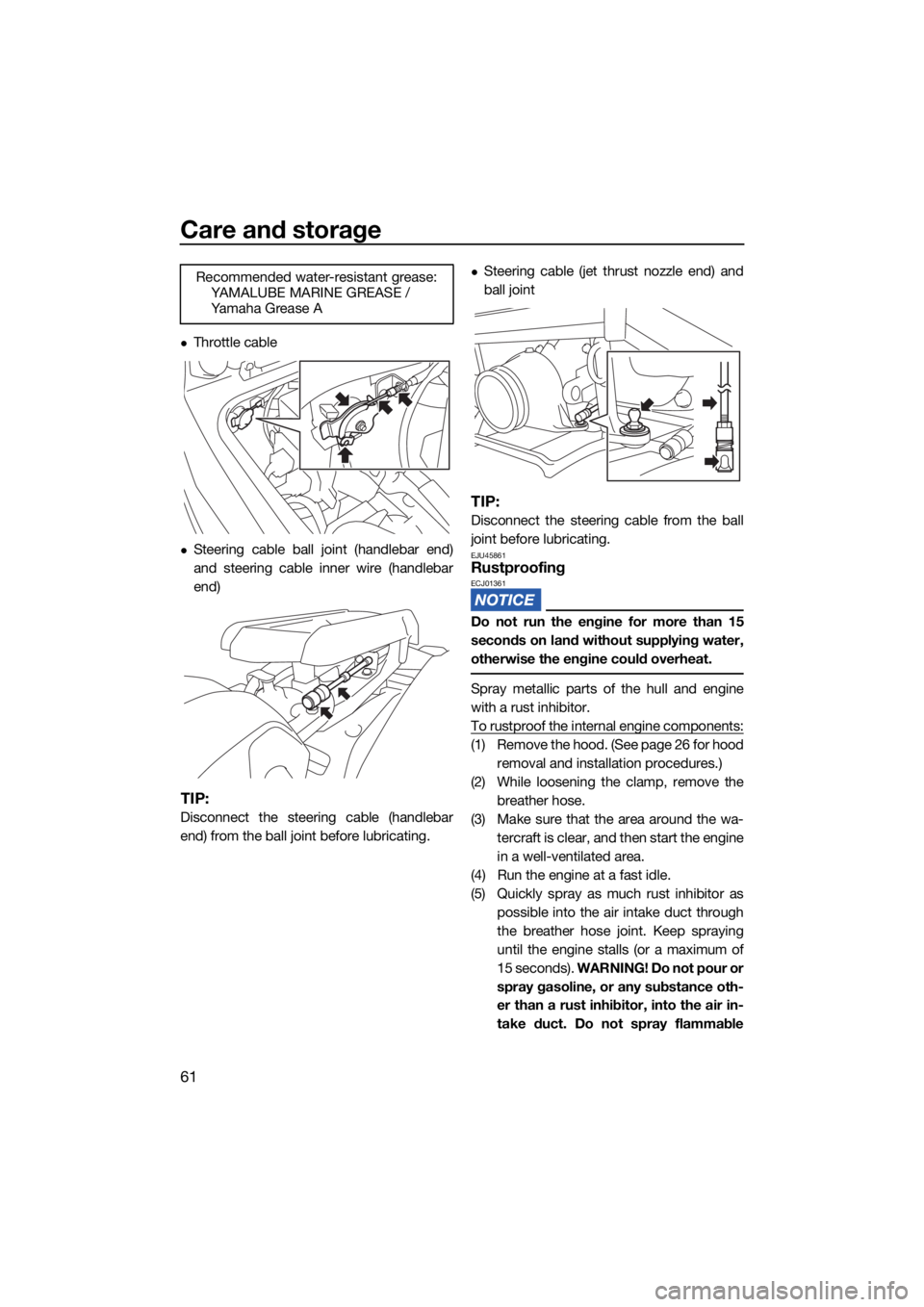
Care and storage
61
Throttle cable
Steering cable ball joint (handlebar end)
and steering cable inner wire (handlebar
end)
TIP:
Disconnect the steering cable (handlebar
end) from the ball joint before lubricating.
Steering cable (jet thrust nozzle end) and
ball joint
TIP:
Disconnect the steering cable from the ball
joint before lubricating.
EJU45861RustproofingECJ01361
Do not run the engine for more than 15
seconds on land without supplying water,
otherwise the engine could overheat.
Spray metallic parts of the hull and engine
with a rust inhibitor.
To rustproof the internal engine components:
(1) Remove the hood. (See page 26 for hoodremoval and installation procedures.)
(2) While loosening the clamp, remove the breather hose.
(3) Make sure that the area around the wa- tercraft is clear, and then start the engine
in a well-ventilated area.
(4) Run the engine at a fast idle.
(5) Quickly spray as much rust inhibitor as possible into the air intake duct through
the breather hose joint. Keep spraying
until the engine stalls (or a maximum of
15 seconds). WARNING! Do not pour or
spray gasoline, or any substance oth-
er than a rust inhibitor, into the air in-
take duct. Do not spray flammable
Recommended water-resistant grease:
YAMALUBE MARINE GREASE /
Ya m a h a G r e a s e A
UF4R71E0.book Page 61 Monday, May 10, 2021 1:14 PM
Page 79 of 84
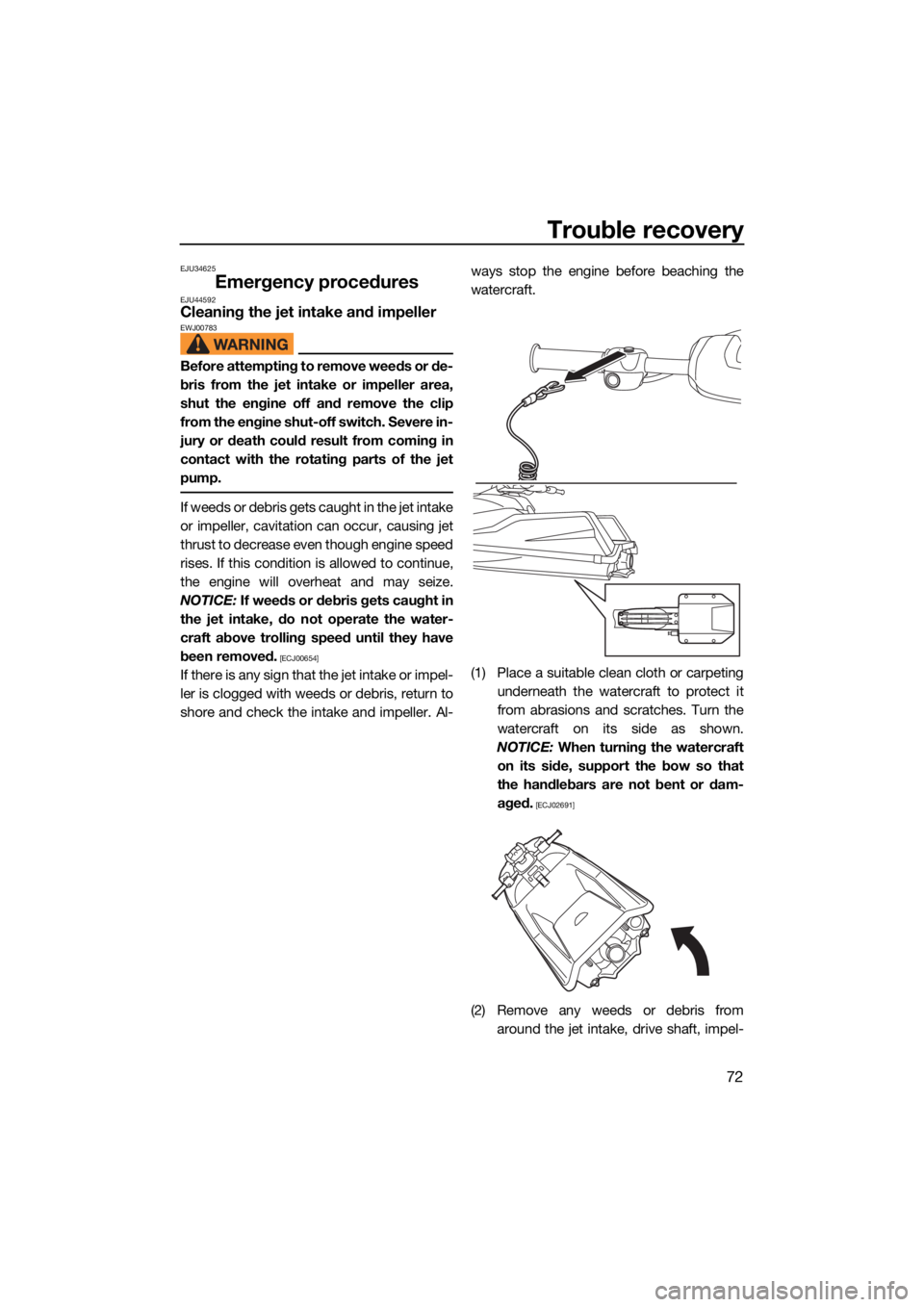
Trouble recovery
72
EJU34625
Emergency proceduresEJU44592Cleaning the jet intake and impellerEWJ00783
Before attempting to remove weeds or de-
bris from the jet intake or impeller area,
shut the engine off and remove the clip
from the engine shut-off switch. Severe in-
jury or death could result from coming in
contact with the rotating parts of the jet
pump.
If weeds or debris gets caught in the jet intake
or impeller, cavitation can occur, causing jet
thrust to decrease even though engine speed
rises. If this condition is allowed to continue,
the engine will overheat and may seize.
NOTICE: If weeds or debris gets caught in
the jet intake, do not operate the water-
craft above trolling speed until they have
been removed.
[ECJ00654]
If there is any sign that the jet intake or impel-
ler is clogged with weeds or debris, return to
shore and check the intake and impeller. Al- ways stop the engine before beaching the
watercraft.
(1) Place a suitable clean cloth or carpeting
underneath the watercraft to protect it
from abrasions and scratches. Turn the
watercraft on its side as shown.
NOTICE: When turning the watercraft
on its side, support the bow so that
the handlebars are not bent or dam-
aged.
[ECJ02691]
(2) Remove any weeds or debris from around the jet intake, drive shaft, impel-
UF4R71E0.book Page 72 Monday, May 10, 2021 1:14 PM